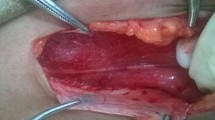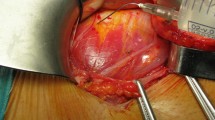Abstract
Background
Chronic post-operative inguinodynia occurs in about 10 % of patients undergoing inguinal hernioplasty with prosthesis; it is characterized by a broad pleomorphism of symptoms, including relative to individual variability of algic perception. Its intensity can also potentially jeopardize patient’s work and social activities. The most notorious cause of inguinodynia is neuropathy, resulting from the involvement of one or more inguinal nerves (iliohypogastric, ilioinguinal and genitofemoral nerves) in fibroblastic processes, or from nervous stimulation, caused by prosthetic material on adjacent nervous trunks. The aim of our study was to provide a comparative analysis between outcomes of wide nerve resection vs. nerve sparing.
Patients and methods
In our hospital, between 2000 and 2010, 600 patients underwent monolateral prosthetic inguinal hernia repair, using the original Trabucco technique. In 345 cases, to avoid chronic post-operative pain, we carried out intentional neurectomy, between 3 and 8 cm in length of either the main and/or peripheral branches of the iliohypogastric nerve, ilioinguinal nerve and the genital branch of the genitofemoral nerve, deemed at risk of entrapment because of the prosthetic material. In the control group, which included the other 255 patients, nerves were identified and spared. Follow-up was scheduled at 1 week, 1 month and 1 year after surgery.
Results
Case: 1 week after the operation, 135 patients (39.1 %) did not show pain, 201 (58.3 %) reported moderate pain and 9 (2.6 %) showed intense pain; 1 month after the procedure, 300 patients (87 %) did not have pain, 39 (11.3 %) complained of moderate pain and 6 (1.7 %) demonstrated severe pain; 1 year after surgery, only two patients (0.6 %) complained of persistent pain.
Control: At the 1-week follow-up, 114 patients (44.7 %) did not show pain, 111 (43.5 %) reported moderate pain and 30 (11.8 %) intense pain; 1 month after the procedure, 183 patients (71.8 %) did not have pain, 45 (17.6 %) complained of moderate pain and 27 (10.6%) showed severe pain; 1 year after surgery, 11 patients (4.3 %) had persistent pain, and two of them were re-submitted to surgery. The lower incidence of chronic pain after nerve resection is statistically significant (0.6 vs. 4.3 % p = 0.0048); the incidence of moderate pain 1 month after the operation is also lower (11.3 vs. 17.6 % p = 0.0097). In addition, among patients subjected to nerve resection there is a faster resolution of algetic symptomatology, over the course of a month; also noteworthy is the lower incidence of intense pain in the short-and medium-term (after 1 week, 11.8 vs. 2.6 % p = 0.0006 ; after 1 month, 10.6 vs. 1.7 % p < 0.0001).
Conclusions
Despite the apparent paradox of an higher tissue damage, elective neurectomy of selected segments of inguinal nerves, appears an effective technique in preventing chronic postherniorraphy pain, considering both the lower incidence and the faster resolution of painful symptomatology.

Similar content being viewed by others
References
Cunningham J, Temple WJ, Mitchell P (1996) Cooperative hernia study: pain in the postrepair patient. Ann Surg 224:598–602
Proobalan AS, Bruce J, King PM (2001) Chronic pain and quality of life following open inguinal hernia repair. Br J Surg 88:1122–1126
Courtney CA, Duffy K, Serpell MG (2002) Outcome of patients with severe chronic pain following repair of groin hernia. Br J Surg 89:1310–1314
Callesen T, Bech K, Kehlet H (1996) Prospective study of chronic pain after groin hernia repair. Br J Surg 86(12):1528–1531
Classification of chronic pain (1986) Descriptions of chronic pain syndromes and definitions of pain terms. Prepared by the International Association for the Study of Pain, Subcommittee on Taxonomy. Pain Suppl 3:S1–S226
Amid PK (2004) Causes, prevention and surgical treatment of post herniorrhaphy neuropathic inguinodynia: triple neurectomy with proximal end implantation. Hernia 8:343–349
Lichtenstein IL, Shulman AG, Amid PK (1988) Cause and prevention of postherniorrhaphy neuralgia: a proposed protocol for treatment. Am J Surg 155(6):786–790
Dittrick GW, Ridl K, Kuhn JA (2004) Routine ilioinguinal nerve excision in inguinal hernia repairs. Am J Surg 188:736–740
Tsakayannis DE, Kiriakopoulos AC, Linos DA (2004) Elective neurectomy during open “tension-free” inguinal hernia repair. Hernia 8:67–69
Ducic I, Lee A (2004) Dellon; Testicular pain after inguinal hernia repair: an approach to resection of the genital branch of genitofemoral nerve. J Am Coll Surg 198:181–184
Amid PK (2002) A 1-stage surgical treatment for post herniorrhaphy neuropathic pain: triple neurectomy and proximal end implantation without mobilization of the cord. Arch Surg 137(1):100–104
Trabucco EE (1993) The office hernioplasty and the Trabucco repair. Ann Ital Chir 64(2):127–149
Jensen MP, Chen C, Brugger AM (2003) Interpretation of visual analog scale ratings and change scores: a reanalysis of two clinical trials of postoperative pain. J Pain 4(7):407–414
Vuilleumier H, Hubner M (2009) Neuropathy after herniorrhaphy: indication for surgical treatment and outcome. World J Surg 33:841–845
Loos MJ, Scheltinga MR, Roumen RM (2010) Tailored neurectomy for treatment of postherniorrhaphy inguinal neuralgia. Surgery 147(2):275–281
Zacest AC, Magill ST, Anderson VC (2010) Long-term outcome following ilioinguinal neurectomy for chronic pain. J Neurosurg 112:784–789
Johner A, Faulds J, Wiseman SM (2011) Planned ilioinguinal nerve excision for prevention of chronic pain after inguinal hernia repair: a meta-analysis. Surgery 150(3):534–542
Mui WL, Ng CSH, Fung TM (2006) Prophylactic ilioinguinal neurectomy in open inguinal hernia repair. Ann Surg 244:27–33
Karakayali F, Oksuz E, Turk E (2010) Effectiveness of multiple neurectomies to prevent chronic groin pain after tension-free hernia repair. Int Surg 95:40–48
Smeds S, Lofstrom L, Eriksson O (2010) Influence of nerve identification and the resection of nerves “at risk” on postoperative pain in open inguinal hernia repair. Hernia 14:265–270
Amer MS, Ashraf M (2009) Inguinal neuroplasty: elective neurectomy for postoperative neuralgias. Prof Med J 16(4):475–480
Alfieri S, Rotondi F, Di Giorgio A (2006) Influence of preservation versus division of ilioinguinal, iliohypogastric, and genital nerves during open mesh herniorrhaphy. Ann Surg 243(4):553–558
Reinpold WMJ, Nehls J, Eggert A (2011) Nerve management and chronic pain after open inguinal hernia repair. Ann Surg 254(1):163–168
Coleman MP, Freeman MR (2010) Wallerian degeneration, wld(s), and nmnat. Ann Rev Neurosci 33:245–267
Conflict of interest
Nothing to declare.
Author information
Authors and Affiliations
Corresponding author
Rights and permissions
About this article
Cite this article
Zannoni, M., Nisi, P., Iaria, M. et al. Wide nervous section to prevent post-operative inguinodynia after prosthetic hernia repair: a single center experience. Hernia 19, 565–570 (2015). https://doi.org/10.1007/s10029-014-1248-2
Received:
Accepted:
Published:
Issue Date:
DOI: https://doi.org/10.1007/s10029-014-1248-2




